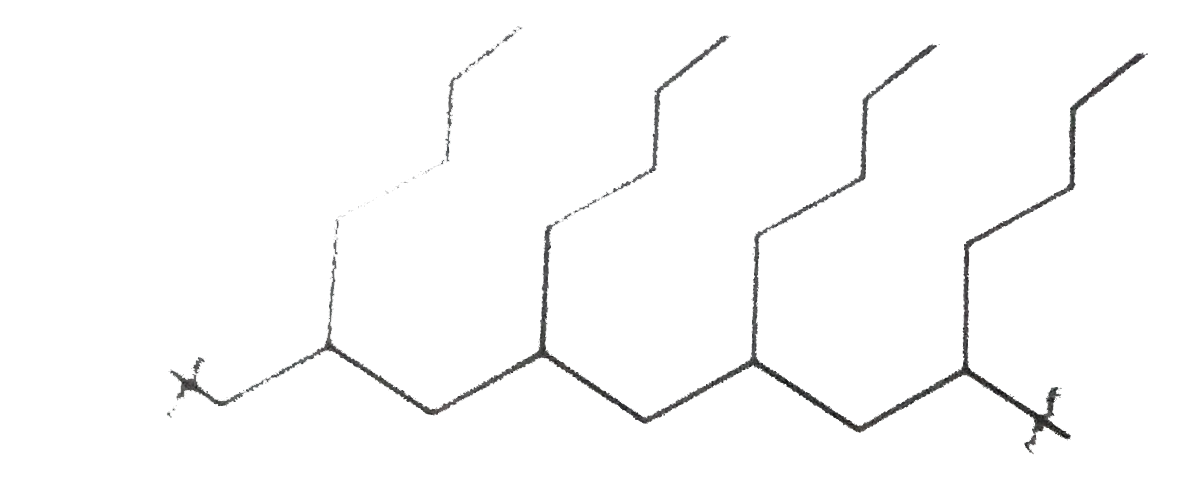Free radical polymerization
terylene
melamine
Neylon 6,6
Teflon
To solve the question regarding free radical polymerization and identify which polymer undergoes this process, we can follow these steps:
Step 1: Understand the Types of Polymerization
Polymerization can be broadly classified into two types:
1. Condensation Polymerization: This type involves the reaction of monomers with the elimination of small molecules, often water.
2. Addition (Free Radical) Polymerization: This type involves the addition of monomers without the loss of any small molecules, typically initiated by free radicals.
Step 2: Analyze the Given Polymers
The question provides four polymers: Pteriline, Melamine, Nylon 6-6, and Teflon. We need to determine which of these undergoes free radical polymerization.
- Pteriline (Dechrone): This is a condensation polymer that forms by the reaction of monomers with the loss of water.
- Melamine: This is also a condensation polymer, formed through a reaction that releases water.
- Nylon 6-6: This is another example of a condensation polymer, where water is lost during the polymer formation.
- Teflon: The monomer for Teflon is tetrafluoroethene (CF2=CF2), which can undergo free radical polymerization.
Step 3: Identify the Polymer Undergoing Free Radical Polymerization
From the analysis:
- Pteriline, Melamine, and Nylon 6-6 are all condensation polymers.
- Teflon, derived from tetrafluoroethene, undergoes free radical polymerization.
Conclusion
The polymer that undergoes free radical polymerization is Teflon. Therefore, the correct answer is option 4.
Polymerization can be broadly classified into two types:
1. Condensation Polymerization: This type involves the reaction of monomers with the elimination of small molecules, often water.
2. Addition (Free Radical) Polymerization: This type involves the addition of monomers without the loss of any small molecules, typically initiated by free radicals.
The question provides four polymers: Pteriline, Melamine, Nylon 6-6, and Teflon. We need to determine which of these undergoes free radical polymerization.
- Melamine: This is also a condensation polymer, formed through a reaction that releases water.
- Nylon 6-6: This is another example of a condensation polymer, where water is lost during the polymer formation.
- Teflon: The monomer for Teflon is tetrafluoroethene (CF2=CF2), which can undergo free radical polymerization.
From the analysis:
- Pteriline, Melamine, and Nylon 6-6 are all condensation polymers.
- Teflon, derived from tetrafluoroethene, undergoes free radical polymerization.
The polymer that undergoes free radical polymerization is Teflon. Therefore, the correct answer is option 4.
Topper's Solved these Questions
Similar Questions
Knowledge Check
Free radical polymerisation requires a free radical initior.The most commonly used free radical initiator is:
APh−CO−O−O−COPh , benzoylperoxideB(CH3)3C−O−O−C(CH3)3 , tert-butyl peroxideCC6H5−N∣∣C6H5−N→O , azoxybenezeneDCH2N2 , diazomethaneWhich of the follwing compounds may be employed as a free radical initiator for free redical polymerizations?
AAzobbisisobutyronitrile (AIBN)BDi-tert-butyl peroxideCDibenzyl peroxideDAll of theseThe following structure represents a subunit of a hydrocarbon polymer that may be prepared by a radical polymerization method. Identify the monomer that been polymerized to make this polymer chain.
 A
A B
B C
C D
D
Introduction OF Free Radicals|| Combination & Disproportion Reaction|| Formation OF Free Radical||Wurtz Reaction||Examples OF All Reaction
View SolutionWrite the name and structure of one of the common initiators used in free radical addition polymersations.
View SolutionFree radical properties || generation OF radical characteristics || reaction OF free radical
View SolutionAssertion: For a free radical combination, K=A.
Reason: Ea is zero for free radical combination.
View SolutionIn free radical mechanism of polymerization of addition polymer the chain propagation step is
View Solution
